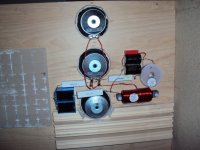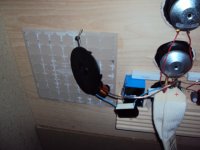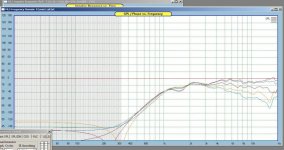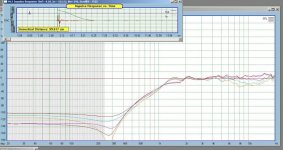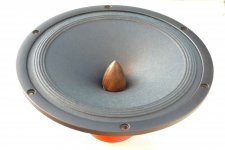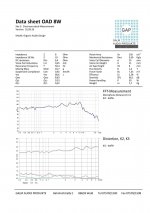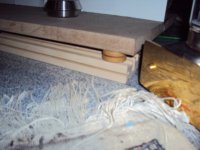I got the second one ready and i am listening since half an hour. What i hear is good but somehow this version does not have the lifelyness of the single driver version. Somehow i expected that because energy is now shifted to the lower reaches. I thounght about a solution. Actually i was prepared in my mind. i had heard the Linkwitz Orion in Siegfrieds house before the Orion plus modification and although it had a very attractive and natural sound i missed some life and exitement. It was like listening to a lower colouration and much better imaging version of a clasical Spendor BC1 one but with that typical ( for a european ) robust american bass. Well, the bass was not boomy at all but i missed some timeing information. When i came back into Siegfrieds house he had added the rear tweeter and was still experimenting with level. The transformation was astounding. Even better depth perpectives and a much more transparent and lifely sound. I thought that could be the solution here too. In my collection i have some SEAS 19TFF1 tweeters that are much underated. I see them seldom in commercial products but with an extention up to 30kHz and a very flat response from 1kHz on i can find nothing that could explain that. Add the low cost and you have a nearly perfect supertweeter that costs very little. Sensitivity is 89dB and this is perfect for an add on of the Mini MPL. They have a sensitivity of 86dB but beeing a dipole the room helps out and we land in the correct ballpark. I simply istalled the 19TFF1 in the back on some springs aproximately at the height of the midrange driver slightly on the outer side and firing a bit out. As you may have guessed when i build a spaeker for myself, i use measurements only as a guideline and use intuition, experience and my own ears instead. I have to please no one. This is my privat speaker. I use a second order crossover without resistor and from an energy point of view they blended perfectly well. I use them in revers polarity and that seems to be the right way to do it but because i have the tweeters on aligator clips i can play aound with phase too. I will post a photo soon and will have more impressions concerning the sound.
Here is a photo of the arangement i use. You may ask why i just put the tweeter on the back in open air without a baffle. This will give some conciderable combfiltering. Well, this is exactly what i want. I follow a diffent philosophy here that is not similar to what Linkwitz or for that matter even stronger Kreskovky does in his Nao Note. I do not want that the back radiation is a 1/1 copy of the frontal radiation, just of oposite phase. I owned speakers like that, for example several Quads and Appogees. The problem is that they do not work well in smaller rooms. The Quad is less critical here then the Appogee because it has some damping of the back wave and is not a linesource that needs the far field to work. Anyway, my room is 28qm and this is around the upper range of a typical sized german living room. I was at many customers and few had rooms bigger then 30qm. Provided now you put a dipole in that room that has the same radiation on back and front there is a good chance that the back radiation hits the backwall somewhere and when that refexion is not damped you get a second time delayed phantom immage. The result is a sound that is more difuse then a sound that whould cary immage information only ones. In fact a have a pattent that contains the appication of phantom images that cary the imaging information and not the direct radiation so i know how strong information content in single reflexions can be especially when they contain higher frequency energy. The original Quad ELS57 had the backwave damped in the treble to avoid imaging problems in smaller rooms.
For me that is also not the way to go. I want that the radiated energy is the same on the back and the front of my speaker but only the front radiation carries time coherent immaging information. In fact the frontal frequency response of the mini MPL is slightly difuse field equalized. The frequency response between 10 and 20Khz is slightly lifted to compensate for bundeling of the front driver in that aerea. I then cross the baffles some 30cm before my ears. Ted Jordan gave an excellent explanation why that is beneficial. He found that this arangement gives a stronger focussed sound and a wider sweetspot. The radiation on the back of the BMB Mini MPL with ambient tweeter has a good tonal balance ( tonal balance sounds good when i hear from the back ) but is not correlated in phase with the front radiation especially in the area over 1kHz where imaging information is. The result is a speaker with excellent image focus. When i switch on the ambient tweeters the sound gets more lifely and depth perspectve is even better rendered. In fact the Mini MPL BWBA ( bass-wideband-bass, ambient).
Although i sit closer to the Mini MPL then i do to the big MPL it projects deeper into the backround. The big MPL sounds more up front and bigger in spacial terms. It is like the Mini MPL had taken the same sound the the big MPL makes, pushes it 5 meter back and
and by the laws of perspective that sound also seems to be smaler in size but not in proportion. When you ask me if i coud live without the MPL and only had a Mini MPL i whould say no. The MPL just has an amasing resoving power and enormous dynamic range making listening like a ride in a Porsche Turbo on the German Autobahn by night.
But if you ask me if i enoy the sound hat the Mini MPL BWBA makes i whould say yes, absolutely with a smile on my face. I whould miss that sound too if somebody whould take them away from me. This is the little brother of the big sister and i love all of my children.
For me that is also not the way to go. I want that the radiated energy is the same on the back and the front of my speaker but only the front radiation carries time coherent immaging information. In fact the frontal frequency response of the mini MPL is slightly difuse field equalized. The frequency response between 10 and 20Khz is slightly lifted to compensate for bundeling of the front driver in that aerea. I then cross the baffles some 30cm before my ears. Ted Jordan gave an excellent explanation why that is beneficial. He found that this arangement gives a stronger focussed sound and a wider sweetspot. The radiation on the back of the BMB Mini MPL with ambient tweeter has a good tonal balance ( tonal balance sounds good when i hear from the back ) but is not correlated in phase with the front radiation especially in the area over 1kHz where imaging information is. The result is a speaker with excellent image focus. When i switch on the ambient tweeters the sound gets more lifely and depth perspectve is even better rendered. In fact the Mini MPL BWBA ( bass-wideband-bass, ambient).
Although i sit closer to the Mini MPL then i do to the big MPL it projects deeper into the backround. The big MPL sounds more up front and bigger in spacial terms. It is like the Mini MPL had taken the same sound the the big MPL makes, pushes it 5 meter back and
and by the laws of perspective that sound also seems to be smaler in size but not in proportion. When you ask me if i coud live without the MPL and only had a Mini MPL i whould say no. The MPL just has an amasing resoving power and enormous dynamic range making listening like a ride in a Porsche Turbo on the German Autobahn by night.
But if you ask me if i enoy the sound hat the Mini MPL BWBA makes i whould say yes, absolutely with a smile on my face. I whould miss that sound too if somebody whould take them away from me. This is the little brother of the big sister and i love all of my children.
Attachments
Hi, Joachim.
I'm looking for nice company for Supravox 135lb. I really like your design so I'm thinking to try your crossover point with this Neo CD3.5H horn loaded ribbon of yours.
It has high efficiency and nice frequency responce. The other option I'm considering is Neo CD3. I is rated only 93db/w SPL but I've noticed that in the frequency range that we're interested in (8khz and up) they are very similar. Both are about 96-97db/w SPL.
The thing that bothers me is choosing the right off-axis response.
I've been watching the graphs of both tweeters for a while and I have doubts if such a narrow firing tweeter (cd3.5h) is really needed.
Isn't a regular ribbon enough ? It's also pretty directional by its nature.
How do you feel about it ? Does your setup suffer from beaming of the horn tweeter ? Isn't the sweetspot too narrow so one can feel uncomfortable with it ?
I'd be grateful to know your opinion.
Regards,
Kuba
PS. I've attached cd3.5H on left and Neo cd3.0 on the right
I'm looking for nice company for Supravox 135lb. I really like your design so I'm thinking to try your crossover point with this Neo CD3.5H horn loaded ribbon of yours.
It has high efficiency and nice frequency responce. The other option I'm considering is Neo CD3. I is rated only 93db/w SPL but I've noticed that in the frequency range that we're interested in (8khz and up) they are very similar. Both are about 96-97db/w SPL.
The thing that bothers me is choosing the right off-axis response.
I've been watching the graphs of both tweeters for a while and I have doubts if such a narrow firing tweeter (cd3.5h) is really needed.
Isn't a regular ribbon enough ? It's also pretty directional by its nature.
How do you feel about it ? Does your setup suffer from beaming of the horn tweeter ? Isn't the sweetspot too narrow so one can feel uncomfortable with it ?
I'd be grateful to know your opinion.
Regards,
Kuba
PS. I've attached cd3.5H on left and Neo cd3.0 on the right
Attachments
Last edited:
I use the horn Ribbon out of two reasons. First at the crossover frequency of 8kHz i use the wideband has already a slightly restricted radiation pattern and the radiation pattern of the Horn Ribbon that looks very similar to a waveguide fits the wideband better. That slight beeming that goes constantly up with frequency makes the MPL focus really well. I compensate the energy loss at higher frequencyes in newer versions with an aditional backtweeter, see the Mini MPL. The energy at the back of the MPL needs to sound the same as the frontal radiation and i slowly develop a theory how that response has to be shaped.A linear freefield response is not right because the ear has a diffent sensitivity for frontal diect incidence and sidewise difuse incidence. See Zwicker
at.all. for more information. So far i am only listening by standing some distance behind the MPL and then walking though the pair and listen at the listening seat. It is important that the back radiation does not create and aditional phantom immage like in a conventional dipole. This is empiric research at the moment and when i get the optimum subjective result i will measure and do the thing all over again. Listen-Measure-Listen-Measure at infinitum until i get a more or less consistent reading. That may then be only true in my particular room and setup, hence the tittle MPL. My Privat Loudspeaker. The other reason i use the horn that is has some timedelay that by coincidence perfectly fitted the delay in the wideband cone so i got a nearly phase cohrent result with only 3 components in the crossover.
at.all. for more information. So far i am only listening by standing some distance behind the MPL and then walking though the pair and listen at the listening seat. It is important that the back radiation does not create and aditional phantom immage like in a conventional dipole. This is empiric research at the moment and when i get the optimum subjective result i will measure and do the thing all over again. Listen-Measure-Listen-Measure at infinitum until i get a more or less consistent reading. That may then be only true in my particular room and setup, hence the tittle MPL. My Privat Loudspeaker. The other reason i use the horn that is has some timedelay that by coincidence perfectly fitted the delay in the wideband cone so i got a nearly phase cohrent result with only 3 components in the crossover.
Thank for your answer. I'm going to try 3.5H in some time.
In fact your last posts got my interest. I don't fully understand HOW did you avoid delayed phantom image with the back tweeters.
Is it because ?:
a) back tweeters are not perfectly out of phase with high frequences in front which causes comb filtering
b) they do not fire directly onto back wall
c) their off axis response is very good, so reflected sound gets even more diffused
PS. Could you paste a link to Zwicker's paper ? I can't find it on the web.
In fact your last posts got my interest. I don't fully understand HOW did you avoid delayed phantom image with the back tweeters.
Is it because ?:
a) back tweeters are not perfectly out of phase with high frequences in front which causes comb filtering
b) they do not fire directly onto back wall
c) their off axis response is very good, so reflected sound gets even more diffused
PS. Could you paste a link to Zwicker's paper ? I can't find it on the web.
Hello, yes your findings are correct but this is a work in progress so i can not tell exactly at the momonet how it is correctly done. You can find the frequency curve for diffuse field equalisation on the Linkwitz Lab - Loudspeaker Design page under the information about the tuning of the new Orion. I think Siegfried is into something interesting there too but we attack the problem from a different angle. The only advice i can give you at the moment is : yours your ears and your intuittion and you will be rewarded. By the way, Zwicker did a book about acoustics. Maybe you can find a free download on the web or you have to go the expensive way and buy it. It should be edjucating because here in germany he is more or less the "pope" of electro acoustics.
Hello,
Are you refering to the "BBC dip"? I have the book Zwicker/Fastl: Psychoacoustics - Facts and Models and there is some information about perception of loudness. This interests mee too, because I'd like to find the optimum for the speaker + room problem in terms of perception. The loudness is one issue and it would be nice to find a way to determine from free field responses how the speaker would sound in a room in terms of loudness perception. However this is not an easy matter because loudness depends on signal's level, frequency content, temporality, and masking etc. So not only the loudspeaker and room effects this but it depends on the music you like to listen to. It would seem that there is not only one way to do things correctly, and ultimately it may turn out that at the end it's all about personal preference.
- Elias
Are you refering to the "BBC dip"? I have the book Zwicker/Fastl: Psychoacoustics - Facts and Models and there is some information about perception of loudness. This interests mee too, because I'd like to find the optimum for the speaker + room problem in terms of perception. The loudness is one issue and it would be nice to find a way to determine from free field responses how the speaker would sound in a room in terms of loudness perception. However this is not an easy matter because loudness depends on signal's level, frequency content, temporality, and masking etc. So not only the loudspeaker and room effects this but it depends on the music you like to listen to. It would seem that there is not only one way to do things correctly, and ultimately it may turn out that at the end it's all about personal preference.
- Elias
The BBC speakers have a dip in response. What they use is a direct radiator. My speaker also radiates to the back so i do not plan to implement the BBC dip on the frontal radiation but of cause i could try to shape the frontal radiation too. Elias, you are right. One gets acustomed to the sound of your own particular speaker-room inteface and then you have often dificulties to find another system as good. That is the reason i listen as much as i can to unamplified music in good rooms so my reference is the life sound and not so much my system.
"..... One gets acustomed to the sound of your own particular speaker-room inteface and then you have often dificulties to find another system as good. That is the reason i listen as much as i can to unamplified music in good rooms so my reference is the life sound and not so much my system."
Hi there Joachim Gehard: The more I read of your audio philosophe for a single driver (without mechanical enhancements) extended range type, the more I realize I share your concepts are similar to mine. My wife's string quartet often rehearses at our home, so I can guage how live music sounds in the same room I listen to cd's or black disks, although my usual feeling is to trash the audio system and start over. I also attend rehearsels of the quartet and orchestras she performs in, as well as there stage performances and other orchestras. Hope progress on your new driver is moving along. ...regards, Michael
The 8 inch wideband driver is ready and availlable ! We make it only with Alnico magnet because that works best. One version has a wallnut phaseplug and one version has a maple phaseplug. I will publish measurements and parameters soon.
Veeery nice !
But this: "We make it only with Alnico magnet because that works best" - not nice $$$
Where are they going to be available ?
Send me a PM. We tryed Neodymium ( ferrite is really not an option any more today ) and it will not make the driver much less costly. It is all hand made by the designer. We do not know any driver that is better. Especially distortion is so low that it is a challange to measure. A typical electret microphone is absolutely not good enough so you need a laboratory grade condenser.
Today i made a surprisingly big improvement to my system with very little efford. Last week a friend of mine with very good ears listened for the first time to my MPL. He was very happy with the dynamics and openness and was particular impressed by the deep and tight bass that he found exeptionally well integrated into the whole picture. He was not that happy with the upper treble that he did find a little bit too prominent and not as well integrated to the wideband as the woofer. He than sat down some centimeters lower and found the sound much improved. He sugested that i should try to lift the MPL baffels by 5 to 10cm from the floor. That makes sense because i had optimised the time domain behaviour on the wideband driver axis. What i did instead is that i agled the baffles slightly back by putting a wooden piece under the stand at the front. The sound i got is now perfectly homogenious from upper midrange to upper treble and i could hear better focus and depth perspectivs. Also one phenomenon got much less that bugs me for a certain time : when i do not listen in the extrem nearfield i usually have to make the right spaeker somewhat louder in my room to center the voice. This time i got nearly perfect focus with the same level on both channels. See a picture of the simpel modification.
Attachments
Again i did some improvements to the MPL baffles. First i am now using the Bönicke Swingbase to decouple the baffles from the floor. I had done experiments with decoupling in recent years too and was very surprised that Bönicke had a product that he was showing on the High End in Munich that uses a different principle but gives aproximately the same result. I had used Squash balls in a sand bed to decouple the Sonics Allegria 2.0 from the floor. With an accelerometer i could measure much less vibration on the wooden floor of my friend that owns them and the other surprise was, that the speakers themselves resonated much less too. I was never reallly confortable to spike speakers to the floor because i think the argument that this forms a "mechanical diode ( Goldmund blurb )" and evacuates the vibration from the speakers is simply not true. In fact that resonance energy makes the floor shake and a lot of that energy reflexes back into the spaeker cabinets where is it again transfered to the floor AD
INFINITUM. Isolating the speakers from the floor by "floating" them on a squash ball cradle or in the case of the Bönicke Swingbase hänging them on steel wires avoids that problem. In fact i could measure around 20dB less vibration on the baffle of the MPL when i "floated" them on the Swingbase. In my case i could not measure any diffence on the floor but i expected that because my floor is 2cm Granite on 50cm concrete diectly on the soil. My listening room is in the souterain and was a car port before i rebuild it. More to come.
INFINITUM. Isolating the speakers from the floor by "floating" them on a squash ball cradle or in the case of the Bönicke Swingbase hänging them on steel wires avoids that problem. In fact i could measure around 20dB less vibration on the baffle of the MPL when i "floated" them on the Swingbase. In my case i could not measure any diffence on the floor but i expected that because my floor is 2cm Granite on 50cm concrete diectly on the soil. My listening room is in the souterain and was a car port before i rebuild it. More to come.
Swingbase
Here are the measurements i did on the MPL baffle with and without the Swingbase. On the baffle i got a ca. 20dB improvement in vibration over a broad fundamental tone area and a smoother response in the bass. On my granite floor i could measue no difference so i have offset the measurement by 20dB for clarity. Otherwise one plot was hiding behind the other.
Here are the measurements i did on the MPL baffle with and without the Swingbase. On the baffle i got a ca. 20dB improvement in vibration over a broad fundamental tone area and a smoother response in the bass. On my granite floor i could measue no difference so i have offset the measurement by 20dB for clarity. Otherwise one plot was hiding behind the other.
Attachments
There have been some favorite reports on this forum regarding a "pendulum mounting" of dipole speakers. While I believe those forum members, your chart looks rather ambiguous to me. I can't see a real and consistent advantage in the curves and by looking at them I can't follow your "On the baffle i got a ca. 20dB improvement in vibration over a broad fundamental tone area and a smoother response in the bass" statement. But it certainly could be a case of "hearing" is believing - instead of "seeing".
Rudolf
Rudolf
